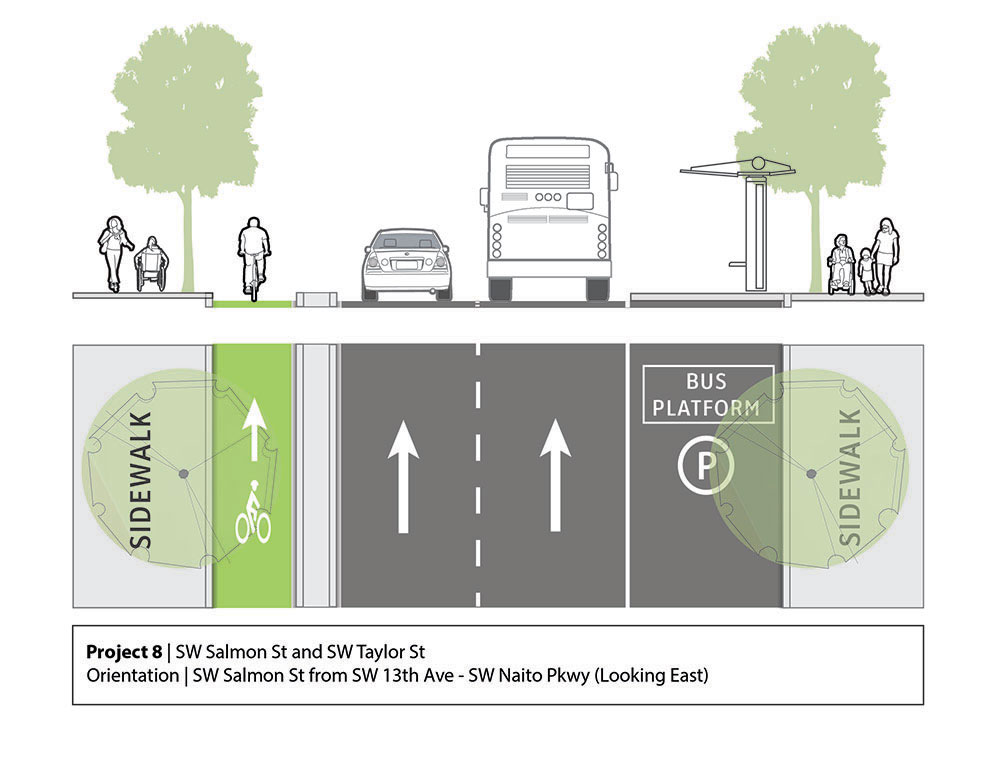In a four-page letter (PDF) sent to Transportation Commmissioner Chloe Eudaly yesterday, Portland Business Alliance President and CEO Andrew Hoan offered carefully mixed doses of support and opposition to projects included in the City of Portland’s Central City in Motion (CCIM) plan.
And in a surprising show of dealmaking, Hoan offered up enthusiastic support for a carfree transit mall in exchange for the City’s proposal to add protected bike lanes to SW Broadway and 4th. And instead of using one lane of Naito Parkway for a protected bike lane, the PBA says they’ll support a new bike path that would bisect the iconic Waterfront Park. Neither of those ideas has been seriously considered in the past two years of discussions about this plan.
With less than a month before the groundbreaking investment in central city streets is scheduled for its first hearing at City Council, many project-watchers have been waiting to see where the PBA stands on the proposals. The organization represents 1,900 businesses and has a history of outsized influence at PBOT and City Hall.
“Broad concern is shared throughout our community that reducing auto capacity on major arterial roads will have significant economic impact to our downtown businesses.”
As we’ve been reporting, the Bureau of Transportation has whittled down 18 projects into two categories — one to be built in 1-5 years, the other for 6-10. In their letter, the PBA weighed in on six projects. They offered outright support for two of them, support “with some modifications” for two others, and proposed “alternatives” for the remaining two. The PBA also addressed the Better Naito project (under the heading #SaferNaito).
Before getting into their project analysis the PBA said as the “employer community” they have, “serious concerns with certain aspects of the proposed projects.”
Hoan writes that, in general, the PBA supports the walking and transit aspects of the CCIM projects; but that bicycling is not as viable, and as such it’s not as worthy of roadway real estate. He even uses the leveling-off of bike commuting rates as reason to not build more protected bike lanes:
For many residents that currently can you buy single occupancy vehicle, making the shift to public transit is the most logical transition… Public transit must be faster and more accessible. Further, we are not opposed to a more connected bicycle network throughout the central city, but broad concern is shared throughout our community that reducing auto capacity on major arterial roads will have significant economic impact to our downtown businesses. Careful consideration should be given to those trade-offs, especially considering that the percentage of portlanders at commute by bicycle has plateaued in recent years.
Hoan doesn’t mention the fact that PBOT analysis shows the CCIM projects will vastly improve the capacity and efficiency of our streets or that PBOT planners count “person trips” and not just automobile volumes.
Let’s start with the projects the PBA supports without conditions: Project 1, which would create protected bike lanes, better crossings, and a bus-only lane on Burnside from W 10th to E 12th; and Project 7, which would add a bus-only on NW Everett from Broadway to the Steel Bridge. “Transit is one of the fastest-growing transportation modes (behind ride-sharing),” the letter states, “and is the most effective in terms of sustainable mass mobility.

The PBA cautions that SW Salmon is rife with conflicts and very valuable as a “portal” for drivers into downtown.
The PBA supports, but would like to modify two other projects: Project 5, which would add bus lanes and bike lanes to SW Jefferson/Columbia/Madison; and Project 8, which would create a protected bike lane couplet on SW Salmon and Taylor.
The PBA likes the transit elements of Project 5, but wants the bike lane axed because they claim it creates conflict near the Highway 26 “portal” and they feel “protection of portal capacity” is more important. “Businesses rely heavily on reliable access to downtown from the surrounding region,” the letter explains. The PBA also wants to keep a bike lane off Jefferson and Columbia because the streets, “provide critical access to several parking garages and numerous loading docks.”
When it comes to Project 8, the PBA’s main concern is that PBOT isn’t doing enough to restore planned reductions in auto parking capacity. PBOT wants to create a protected bike lane on both streets, in the space currently used to park cars. “While we are not opposed to protected bike lanes on these streets,” Hoan states, “it is important to recognize that they are major portals into and out of the central city.”
And this where the PBA unveils one of their core arguments against cycling. Their stance is more cycling space isn’t warranted because not enough people are cycling:
“It must be noted that most visitors to downtown are not taking their bicycles; rather, they are driving. A recent downtown shopper survey show that only 1 percent of retail shoppers use their bike to get to the destination downtown when not commuting for work. With that in mind, PBOT must take careful consideration when removing parking at auto capacity with in this area in favor of less popular transportation modes — especially considering the highway on street parking utilization rate of the downtown core.”
For the other two projects addressed in their letter, the PBA has proposed major changes.
Instead of a new, protected bike lane couplet that would run north-south on Broadway and Fourth (Project 2), the PBA surprisingly says they, “Support the removal of all auto capacity on the transit mall.” Here’s more of the PBA’s pitch for a carfree transit mall:
“Not only would this produce the same north-south connectivity, but drivers typically avoid these streets already or misuse the designated lanes…. turning the auto lane into a protected bike lane would have far less negative impacts on nearby businesses and the design logistics can be smoothed out as they will be for the rest of the projects.”
The PBA feels that putting a protected bike lane on Broadway and 4th, as currently proposed by PBOT, “Would have significant, unnecessary economic impacts on our downtown retail core,” and would “severely limit the capacity of our few remaining arterial routes through the city.” The PBA says carfree lanes on the transit mall would be a “plausible, exciting alternative,” and that offering it up should be a sign that, “supporting alternative transportation is indeed a top priority.”
The final project the PBA offers input on in this letter is Better Naito (Project 17).
While they support a protected bike lane on Naito in general, they don’t want it to constrain existing auto capacity. Back in May we covered an idea put forward by Mayor Ted Wheeler that considers creating a northbound protected bike lane in the existing tree line at the western edge of Waterfront Park. The PBA says losing 40 trees is a non-starter and they support building a bike lane through the center of the park. Not only would a center-running bike lane save the trees but it would also, “activate the park and protect bike commuters,” they say.
Read the entire letter for yourself.
— Jonathan Maus: (503) 706-8804, @jonathan_maus on Twitter and jonathan@bikeportland.org
Never miss a story. Sign-up for the daily BP Headlines email.
BikePortland needs your support.
The post Portland Business Alliance lays out stance on Central City in Motion plan appeared first on BikePortland.org.
from BikePortland.org https://ift.tt/2OKbmu7




No comments:
Post a Comment